|
By: Cheyenne Taylor and Sandra K. Ziebold When discussing crime and prevention in domestic violence, we must discuss escalation. Escalation describes when abuse intensifies, either suddenly or gradually. It can also include perpetrating another form of abuse. Victims might stay with their abusers because they believe they can "handle" the abuse. They think things will improve and be how they used to be or blame themselves. When abuse escalates, victims might start realizing they do not have control and feel trapped in the relationship. Escalation also occurs when victims are considering leaving or have attempted to end the relationship. Reports show that 75% of all serious injuries in abusive relationships happen when the victim ends the relationship (National Domestic Violence Hotline). Identifying abuse is happening is the first step to getting help, but finding the courage to leave with limited self-confidence can be extremely challenging. We encourage victims to connect with supportive services to plan their exit, discuss the abuse to build their network, speak with professionals, and take necessary belongings when fleeing. Abuse thrives behind closed doors. Perpetrators of domestic violence rely on the silence of their victims to keep them trapped in the cycle of violence. As allies, we can all be there to listen and believe victims who come forward to report, seek help, or talk about their experiences. Our efforts here at Beacon of Hope Crisis Center are heavily focused on those most at risk of violent domestic violence victimization. In partnership with law enforcement, we are helping to reduce violence and the chance of felony assaults and domestic homicides by working to intervene early before domestic violence escalates. Providing victims with intervention and prevention services helps to reduce crime in our community. It can take approximately seven attempts before a victim permanently leaves an abusive partner. Many factors are at play, and the risk of death is highest when fleeing. The earlier we can intervene and provide mitigation options for all the barriers facing these victims before the violence escalates, the better for us all. The harm to pets, children, and primary victims is exponential, and with each passing day and traumatic incident, the damage compounds. It's more than the horrific long-term trauma, physical life-altering harm inflicted on many and the risk of death; it is also the shaping of the minds and behaviors of the silent witnesses to these crimes. Many children are at significant risk because they witness this model of unhealthy relationship behavior, and sadly, many then become victims or abusers. We must do all that we can to help break the cycle. By intervening early, we can help the primary and secondary victims by giving them the chance for a new, safe life free from the grip of domestic violence. When we can intervene early and get victims safe before domestic violence escalates, we are helping to reduce violence and the chance of felony assaults and domestic homicides. Beacon of Hope Crisis Center served 1,430 new victims of crime in 2022. While serving those new victims, we provided 35,580 case management services and 12,022 follow-ups to existing survivors seeking services. To better serve those in need in our community, we continue to enhance our services, intake process, and accessibility. Out of the 1,430 new victims that requested assistance, two hundred and three disclosed that they were homeless, thirty-four that they were in a same-sex relationship, one hundred and twenty-seven had a disability, sixty-eight had limited English, twenty-eight were undocumented, six were deaf, six were veterans, and forty-eight were pregnant. Six hundred and eight out of the one-thousand four-hundred and thirty cases had children living in the home, and two-hundred and three of the one-thousand four-hundred and thirty had DCS involvement where the child/children were the victims of domestic violence and/or sexual assault or witnessed the violence. Domestic violence is not just physical. It can be emotional, verbal, financial, psychological, sexual, spiritual, and social. Often, in the cycle of abuse, as abusive situations escalate, things do become physical. The prevalence of head trauma and events of strangulation are unfortunately high in this population. It makes screening for brain injury in the intake process when working with individuals who have experienced domestic violence crucial. Too frequently, this is not identified or not identified timely and prolongs the suffering of those who have sustained this trauma. As mentioned earlier, we continue to improve our intake process. This is very exciting because we are asking the right questions, and we need to ask them to intervene in a timely manner. This means that our enhanced intake process is identifying those who have sustained head and neck trauma and strangulation victimization faster. When a victim meets the criteria for critical medical imaging and potential brain injury assessment, we educate them about the medical emergency and refer them for critical medical services. This is a life-saving measure, and we are so proud of this innovative approach! In addition to our intervention and prevention services giving victims access to safety and services and helping to reduce the escalation of crime by abusers, it also can lead to reduced runs by law enforcement to 911 domestic calls. Every time an officer responds to a domestic, the risk of harm to the officers increases with each repeat call because violence escalates. Additionally, men who strangle women are the most dangerous men on the planet. Data shows that cop killers and mass murderers almost always have a history of strangling victims. According to Casey Gwinn, President and Co-Founder of Alliance for Hope International, “Domestic violence stranglers, usually after being trauma-exposed children, are the why of mass murders, and guns are the how." We must intervene as early as possible; we must continue to try to intervene as many times as needed. We must offer prevention services and provide access to everyone; that is critical to mitigate barriers. In 2022, our agency served 301 new victims who reported strangulation victimization in one year. We continue to see a high monthly average of those we serve reporting strangulation victimization. Our intervention and prevention services unequivocally are vital to crime reduction, and a collaborative multi-disciplinary approach is how we best serve those in need. One of the main ways we intervene and prevent further violence is by educating victims on escalation, dangers of strangulation, safety planning, and much more. The more knowledge a victim has in their pocket, the better they can anticipate their abuser's actions, what that means for their safety, and how to respond accordingly. Victims unaware of the dangers often experience multiple strangulation events and think they are OK. They might experience behavior changes, headaches, vision issues, and other symptoms due to the trauma to their head and neck. Victims often turn away the option of seeking immediate medical care due to a lack of education and knowledge about the risks they are facing. We are here to help victims learn, access help, and change the course of their lives. In many cases, we prevent felony assaults and domestic homicides.
By: Cheyenne Taylor and Savannah Archer Victims of domestic violence endure a high percentage of stalking and harassment victimization during and after a relationship ends. Beacon of Hope Crisis Center saw a 47% increase in victims who experienced stalking and harassment from 2020 to 2022. Specifically, technology-facilitated abuse has been on the rise. Victims have reported abusers tracking their phone activity and location through apps, tracking their physical location with the use of Tile Trackers and Apple Air Tags, improper use of other GPS devices, monitoring inside their homes with hidden cameras, misuse of doorbell cameras for surveillance, and other devices manipulated to perpetrate abuse. Our agency can now assist with checking a victim's vehicle for tracking devices; if found, that information can be reported and added to a protective order request for the court's consideration. We are also seeing victims report that abusers are using different apps to send messages when phone numbers or emails are blocked. Stalkers use apps such as social media platforms, banking, school sites, and other sites that don't always have traditional means of blocking content. Victim advocates complete training to help victims create technology and social media safety plans. There is no time to waste when it comes to securing accounts. Technology abuse is prevalent in our increasingly digital society. When abusers cannot access victims in person, they often use technology to monitor, harass, and stalk the victims. This gives abusers more access to perpetrate harm without disrupting their own lives and responsibilities. In one study, the National Network to End Domestic Violence reported that 71% of abusers monitor victims’ device activities, and 54% download stalkerware onto their partners’ devices. It is debilitating for a victim's mental health and affects their ability to utilize technology how the average person does: to take a break from their stressors. When the victim spends significant time at home, like following a medical procedure, working remotely, or during a global pandemic, abuse can become more pervasive. Reports show that the pandemic increased the rate and severity of technology abuse experienced. The pandemic also impacted abusers’ free time due to the loss of employment and working from home, which allowed them to modify or explore technology in new ways to harm victims. Technology abuse has been on the rise, and as technology develops and changes, so will the methods that abusers use to cause digital harm. Commonly, technology abuse can look like tracking devices, harassing messages, demands for intimate pictures or photos, and publishing private information about the victim. Spoofing is another example of technological abuse where the abuser disguises their messages or phone number to impersonate someone or to get around blocked contact settings. We are focused on enhancing prevention and safety planning for all victims at risk of technology-facilitated abuse. Senate Bill 161 passed, and Indiana now has a new law, unlawful surveillance. This bill adds a prohibition against using a tracking device to the list of conditions a court may impose when issuing a protection order. It also increases the penalty for stalking to a Level 5 felony if the offense is committed using a tracking device. A person who knowingly or intentionally places a tracking device on an individual or the individual's property without the individual's knowledge or consent commits unlawful surveillance, a Class A misdemeanor, unless certain exceptions apply, and increases the penalty to a Level 6 felony if the person is the subject of a protective order or has certain prior convictions. This change in the legislature establishes sentence enhancement if a person uses a tracking device to commit or facilitate the commission of a crime. Beacon of Hope Crisis Center will continue to advocate for victims, adapt to the changing times, and request improvements in the legislature to hold abusers accountable.
By: Cheyenne Taylor Women across the world came together after the Italian Supreme Court overturned a rape case in 1992. This case revolved around an 18-year-old girl that was raped by her driving instructor. He was prosecuted and arrested for the crime but appealed his sentence, claiming that they had consensual sex. The Italian supreme court appealed his case, saying that the victim’s jeans were too tight for the rapist to have removed the jeans by himself. So, they argued that she would have had to help her rapist take her pants off, therefore making the act consensual.
Angered by this judgment, Italian women protested by wearing denim jeans and sitting on the steps of the Italian Supreme Court building. Images of these courageous women spread, and the news of the case shocked people across the globe. In 1999, the first American Denim Day was held in LA. Since then, each year, people worldwide wear denim to stand in solidarity with victims of sexual assault and speak out about the harmful effects of victim-blaming, which often results in more pain and suffering for sexual assault victims. Our agency encourages everyone who supports survivors of sexual assault to wear denim this year on #DenimDay in honor of all survivors. Help is Available:
#WeSupportSurvivors #WeServeAll #WeBelieveYou #SAAM By: Shelby Bubnick Every 98 seconds, an American is sexually assaulted.* The prevalence of sexual assault is alarming, and it affects more than the primary victim. Sexual assault can also affect the friends, family, and community of the survivor. If your loved one has been sexually assaulted, it is normal to feel upset, or at a loss for words. In some cases, you may be the first person the survivor has told. This may put pressure on you as you search for the right things to say and do. Consider the following when responding to a loved one that is disclosing they have been sexually assaulted.
Advocates at Beacon of Hope Crisis Center are trained to assist victims of sexual assault by providing support and education. Learn more here. If you would like to speak with an advocate, please call our crisis line (317)731-6140. By: Shelby Bubnick After experiencing trauma, you may be healing from injuries or feeling emotionally drained. It is essential to keep your body healthy and active during this time. Whether it happened recently or many years ago, there are many ways you can cope with short-term and long-term effects of trauma. Reactions to trauma can be psychological, emotional, cognitive, physical, and behavioral. Common reactions to trauma are listed below.
Psychological and Emotional
Coping with trauma can be hard to do on your own, do not hesitate to seek professional help. To speak with an advocate and learn more about services at Beacon of Hope Crisis Center please call our crisis line (317) 731-6140. By: Sandra K. Ziebold Congratulations to our Indianapolis Brackets For Good nonprofit match-up competitor, Brookside Community Development Corporation (Brookside CDC), on winning Round 2 of the #BFG18 tournament. Thank you for being such a great opponent in the tournament. We immensely thank every donor for helping. We displayed a valiant effort but admit Brookside CDC overtook us in the game. Our team here at Beacon of Hope Crisis Center absolutely wanted to win but we are now thrilled to encourage support for Brookside CDC as they advance to a win in Round 3. What I liked best about this match-up is that the Brookside community received a double win in Round 2! The double win is that both of our organizations serve the Brookside neighborhood and both of our organizations benefited from numerous donations! Every organization competing in Brackets For Good wants to advance and keep raising much needed funds. At the same time as we are disappointed that we lost Round 2 we truly couldn't be more thrilled about Brookside Community Development Corporation advancing in the tournament. Brookside CDC is all about play-based childhood trauma reversal initiatives, societal reentry, and focusing on ending generational poverty to create opportunities of renewal and transformation for the residents of Brookside. Please rally behind them Indianapolis, let's help them win Round 3! 46201 is where a large number of the clients we serve at Beacon of Hope Crisis Center reside. Center Township is one of the reasons why we relocated and expanded our agency, ensuring we were accessible by way of a bus-line. We serve all of Central Indiana and our data shows Marion county and Center Township at the top in our service numbers. Beacon of Hope Crisis Center is focused on helping to reduce our overall homicide rates by serving victims of domestic violence and intervening before situations escalate. I encourage everyone reading this to follow us and learn more about the positive difference Beacon of Hope Crisis Center is making in Central Indiana for victims of domestic violence and sexual assault. Please continue to consider us in your portfolio of charities when making individual and mission gifts. Good luck to Brookside CDC in Round 3! Track Their Progress Here Ways to follow and contact Beacon of Hope Crisis Center:
By: Lydia Wood, Victim Advocate and Trauma Therapy Dog Handler It was not my intent upon adopting Echo that he become a therapy dog, but as I grew to know him more it felt like something he needed to do. The healing power of dogs, I think, has many levels. The foundation being that dogs just are. They’re with you in the moment, no matter how uncomfortable. You don’t have to question their motives or if they really love you. You don’t have to wonder if what they’re doing is genuine or not. They don’t get caught up in their own thoughts, opinions, or judgements. They’re pure, and with the struggle of waking up and living in a world with people who may not be exactly how they seem, it’s refreshing to be around a dog who just is.
A therapy dog’s job is to provide comfort where they go. Their very presence is enough to help most people feel more relaxed and taken care of. Echo, however, adds a bit of a deeper level than many therapy dogs I’ve encountered. Soon after I adopted Echo, I realized his whining didn’t coincide with situations that made him anxious, but with when the people around him felt bad. And not only did he mirror one’s emotions, he sought to comfort the people whose energy he was feeding off of. It was with this realization that I decided to name him “Echo,” on account of him echoing the energy of the people around him. Having trained dogs for several years, I knew the simple fact that he reacted to changes in emotions wasn’t completely uncommon. What stuck out to me about Echo was that he knew how you felt, felt it with you, and tried to make you feel better. He didn’t just soak up your emotions, he empathized with them. That caring, and empathy isn’t something that can be trained into a dog. As a victim is navigating the heart breaking and traumatic dynamic of an abusive relationship, or dealing with the aftermath of sexual assault, Echo’s tenderness and genuine presence can add a peace and clarity of mind that may have been otherwise impossible in the complicated world of human interaction. He’ll be there with the victims we advocate for, through the good and the bad, and hopes for nothing in return. NEWS RELEASE Beacon of Hope Crisis Center Adds A Trauma Therapy Dog And Receives Large Donation From Bob’s Discount Furniture
Exciting start to 2018 with additions of comfort for victims of crime receiving services from Beacon of Hope (INDIANAPOLIS, IN—January 25, 2018)—This brand new exciting year of 2018 kicks off for Beacon of Hope Crisis Center (BOHCC) with new additions to the team which includes Echo and his handler Lydia. Comfort abounds to assist with healing at this local agency serving victims of domestic violence and sexual assault here in Central Indiana. Lydia and Echo joined the team on January 1st, Lydia is a Victim Advocate and Echo’s Trauma Therapy Dog Handler. She is getting her masters in psychology and has experience training service dogs for victims suffering from post-traumatic stress. “We are thrilled to add Echo, a trauma therapy dog, and his handler Lydia to our team and touched by the generosity of our corporate partners, Bob’s Discount Furniture. Thanks to their large donation we now have waiting, counseling and meeting room furniture to make those we are serving comfortable while dealing with their traumatic struggles. And adding Echo to our team helps victims dealing with the traumatic dynamics of an abusive relationship or the aftermath of sexual assault.” said Sandra Ziebold, CEO / Executive Director at Beacon of Hope Crisis Center. "One of our main goals as a company is to give back to the community, so we are honored to provide new furniture for the Beacon of Hope Crisis Center to ensure they are well equipped to serve their growing number of clients," said Cathy Poulin, Director of Outreach and Public Relations at Bob's Discount Furniture. Echo knows how you feel, feels it with you, and tries to make you feel better. He doesn’t just soak up your emotions, he empathizes with them. This caring and empathy isn’t something that can be trained into a dog, but this innate gift is what makes Echo an exceptional trauma therapy dog. Echo’s tenderness and genuine presence adds a peace and clarity of mind. He helps the victims we advocate for, through the good and the bad, and hopes for nothing in return. BOHCC served 904 victims of domestic violence and sexual assault this past year, the agencies 2017 annual report is available on their website. The complexity of cases they are managing and the increase in demand for their services continues to grow. BOHCC advocacy services are desperately needed 24/7. BOHCC serves victims in Central Indiana and has advocacy partnerships with local police departments serving victims of crime. In 2018 BOHCC hopes to increase major donor support to help them be able to operate 24/7 and add language services. You can help, learn more and donate now at beaconofhopeindy.org. About Bob’s Discount Furniture Bob’s Discount Furniture provides quality furniture at every day low prices. With furniture stores located across the United States, the Manchester, Connecticut based company has become the 12th-largest U.S. furniture chain. Bob’s is committed to the communities they serve through a variety of charitable giving efforts. Bob’s Discount Furniture Charitable Foundation provides organizations and individuals with over $2.75 million in donations yearly. For more information on Bob's charitable programs, follow Bob’s on Twitter @MyBobs and on our LinkedIn Company Page, and subscribe to Bob’s on YouTube. About Beacon of Hope Crisis Center 501(c)3 Beacon of Hope Crisis Center a Christ-centered organization empowering victims of domestic violence and sexual assault to become self-sufficient by providing safety, support and education. Since 2009 Beacon of Hope, through its Crisis Intervention, Victim Advocacy, Counseling, "Teen Talk" Outreach and Education, Criminal Justice, Economic Sustainability and Foster Pet Programs has offered victims of domestic violence assistance in overcoming barriers that hold them in abusive situations. Beacon of Hope is a non-profit 501(c)(3) organization located in Indianapolis, Indiana. More information about Beacon of Hope can be found at beaconofhopeindy.org. BOHCC Blog: beaconofhopeindy.org/blog Twitter: @bohindyorg Facebook: @Beaconofhopeindy Instagram: @beacon.of.hope.indy January 25, 2018 FOR ADDITIONAL INFORMATION, CONTACT Sandra K. Ziebold, CEO / Executive Director Beacon of Hope Crisis Center 317 731 6131 By Katie Foley Life is full of unexpected changes and we often recognize those changes when it happens to those closest to us. What happens if you start noticing negative changes in a loved ones life? What are the signs of these changes?
Maybe you’ve noticed bruises on a friend or maybe they are constantly negative and showing you a significant change in their confidence. Maybe you’ve even noticed a change in their attitude or personality. Their scarf collection is growing. They don’t laugh anymore. They are always checking their phone and letting their significant other know where they are. While you thought they were always happy, you’re now beginning to question if something is wrong. Reality: domestic violence and abuse can happen to anyone. Sometimes, though, problems are pushed under the table or even denied. Noticing the signs of an abusive relationship can be the first step to ending it. If you immediately think of someone in your life that relates to the points below then we encourage you to take the first step and reach out. There is available help and no one should ever live in fear. Change in habits When someone becomes obsessive about updating their partner on their location or daily activities this may be a sign that something is wrong. Other changes in daily routine and habits may bring light to something more going on behind closed doors. For example, your sister used to always put on makeup, get manicures, and workout. Now, all she does is sulk around and seems to have lost self-confidence. It is possible those changes are the result of domestic violence. Constantly on edge Do they fear their partner all of the time? Do they try everything in their power to never make their partner angry? Are they always complaining of never doing anything right? If answering “yes,” then it is time to step in and help them realize that they aren’t helpless, but that they are worthy of help. Physical wounds Bruises. Scratches. Black Eyes. Jammed Fingers. Lacerations. Above are “obvious” giveaways of physical abuse. Realize that abusers are smart, so these wounds could possibly be in hidden places. Take notice and start asking questions. They’re not communicating While this may seem superficial, it’s important to start noticing how they are communicating is it via text, phone calls, and social media. If they no longer are on social media or even less active – you may have your first sign. If you also notice that your loved one has a “phone manager” and isn’t texting you as often or maybe isn’t even allowed to talk to certain people, then it might be time to talk. Faking emotions “You’ll never find someone else that will love you.” The lie above is a sign that your loved one is being manipulated to stay in a bad situation. If you are noticing that they are forcing smiles and laughs – then it could be time to take action. The more they are faking and lying, the more they will be manipulated to a point of serious abuse. If you or a loved one are a victim of feeling these emotions – it’s time to take back your life. At Beacon of Hope Crisis Center, we are committed to breaking the cycle while empowering victims and survivors to take back their life. From providing emotional support to safety planning, let us be your advocate. For more information, contact our hotline at: (317) 731-6140. By Sandra K. Ziebold
|
About this blog
This blog is about our domestic and sexual violence crisis center, Beacon of Hope. We hope you find it full of helpful information, motivation, creativity, serious facts and positivity. We hope that it will help you know what is happening in our center, in our community and with our events. We hope you follow our blog in support of our organization and our mission. Archives
October 2024
Categories
All
|
|
CAREER opportunities © 2024 Beacon of Hope Crisis Center Privacy Policy Accessibility Statement Training Portal Login |

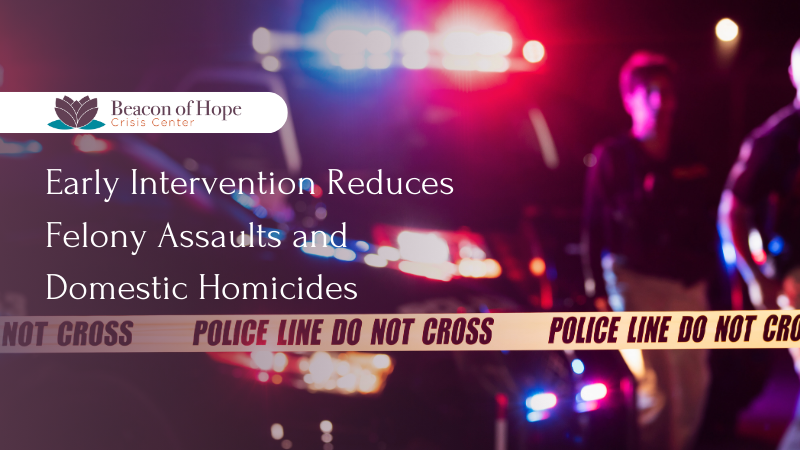
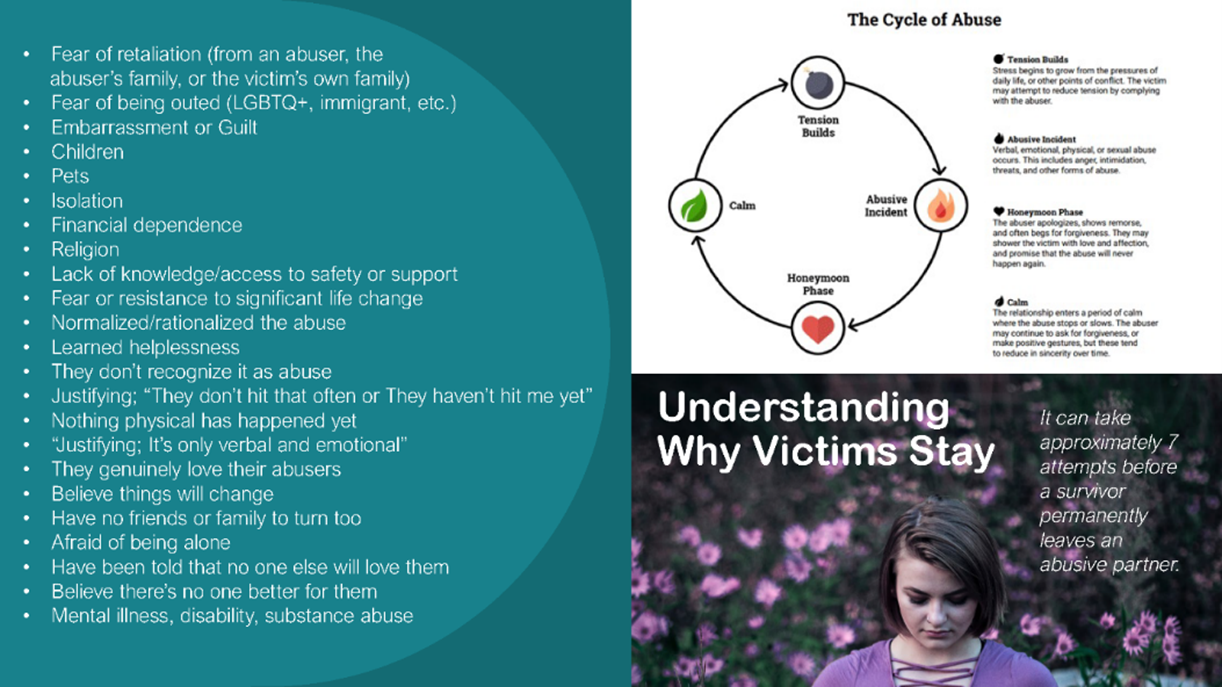

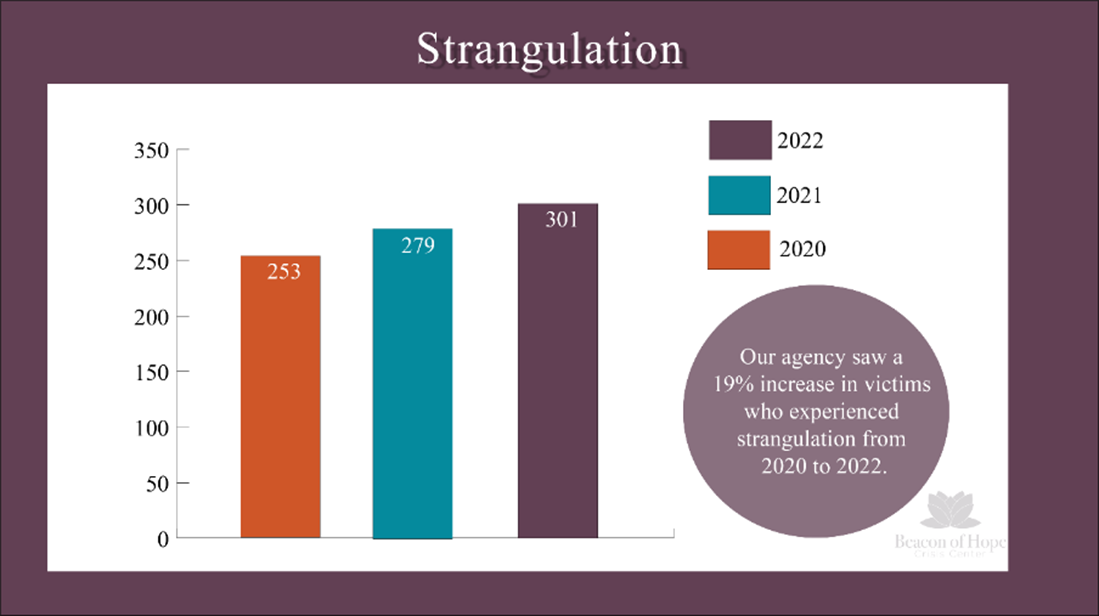
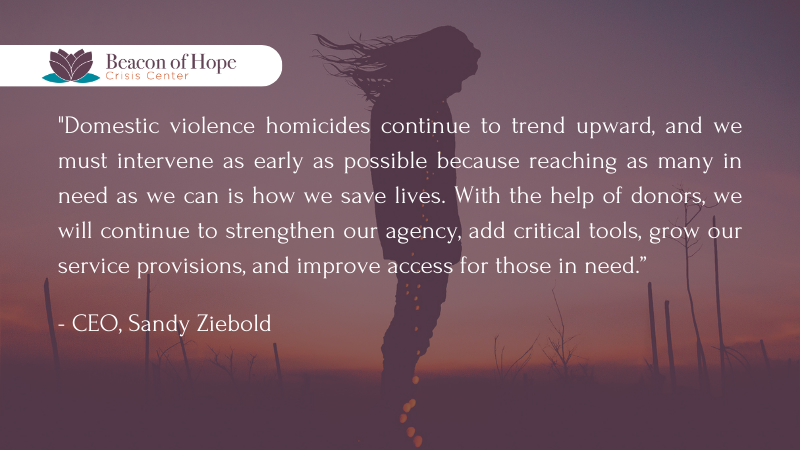
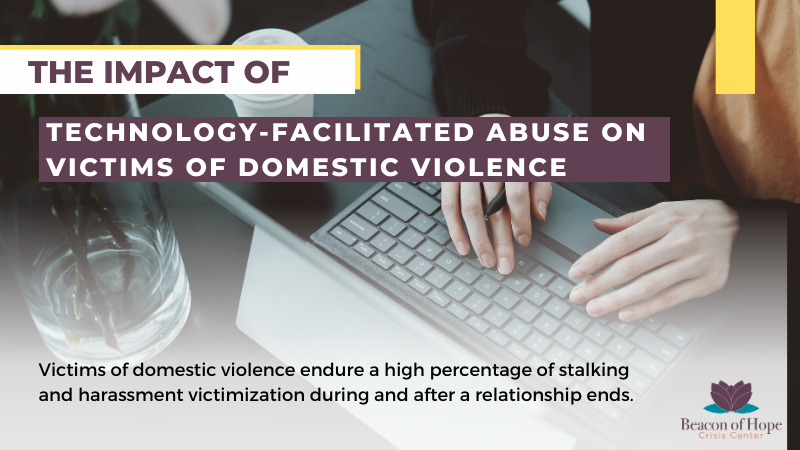
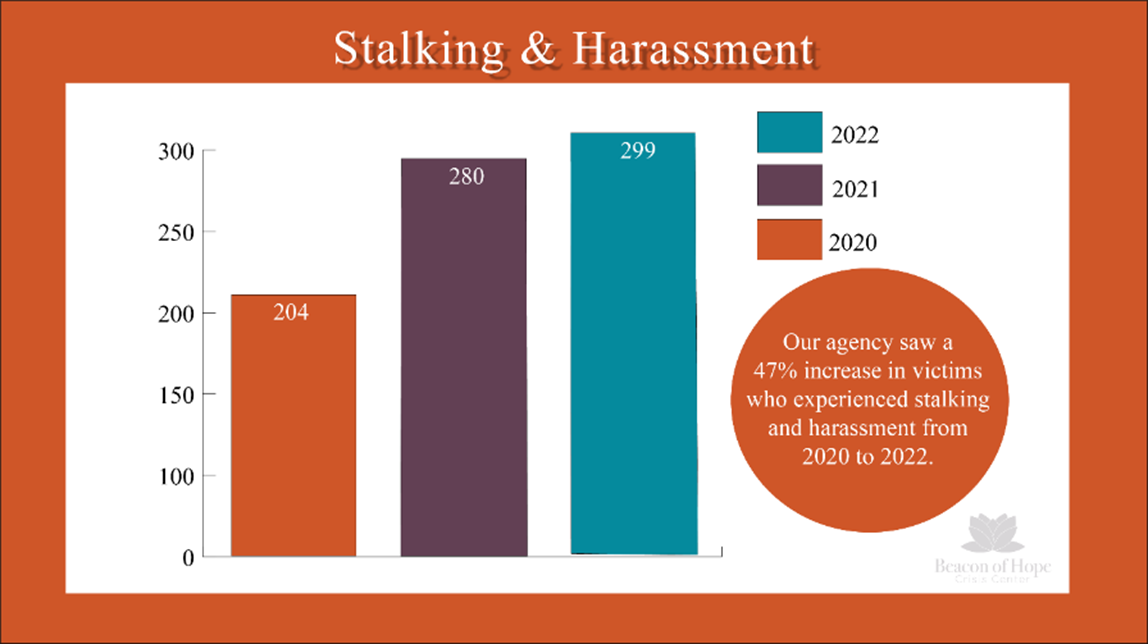










 RSS Feed
RSS Feed